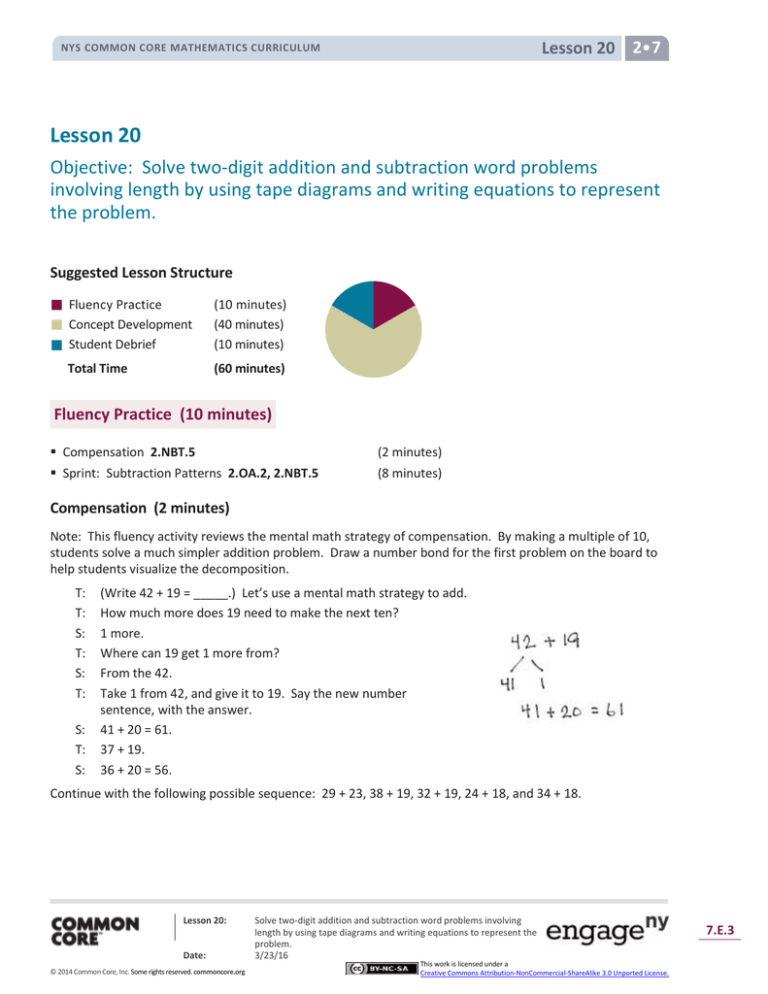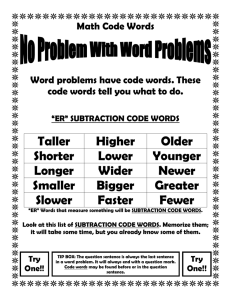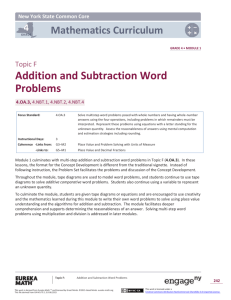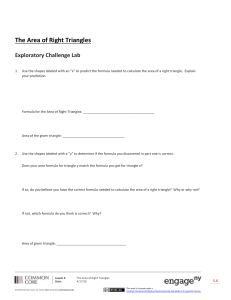
Lesson 20 2 7
NYS COMMON CORE MATHEMATICS CURRICULUM
Lesson 20
Objective: Solve two-digit addition and subtraction word problems
involving length by using tape diagrams and writing equations to represent
the problem.
Suggested Lesson Structure
Fluency Practice
Concept Development
Student Debrief
Total Time
(10 minutes)
(40 minutes)
(10 minutes)
(60 minutes)
Fluency Practice (10 minutes)
Compensation 2.NBT.5
(2 minutes)
Sprint: Subtraction Patterns 2.OA.2, 2.NBT.5
(8 minutes)
Compensation (2 minutes)
Note: This fluency activity reviews the mental math strategy of compensation. By making a multiple of 10,
students solve a much simpler addition problem. Draw a number bond for the first problem on the board to
help students visualize the decomposition.
T:
T:
S:
T:
S:
T:
S:
T:
S:
(Write 42 + 19 = _____.) Let’s use a mental math strategy to add.
How much more does 19 need to make the next ten?
1 more.
Where can 19 get 1 more from?
From the 42.
Take 1 from 42, and give it to 19. Say the new number
sentence, with the answer.
41 + 20 = 61.
37 + 19.
36 + 20 = 56.
Continue with the following possible sequence: 29 + 23, 38 + 19, 32 + 19, 24 + 18, and 34 + 18.
Lesson 20:
Date:
© 2014 Common Core, Inc. Some rights reserved. commoncore.org
Solve two-digit addition and subtraction word problems involving
length by using tape diagrams and writing equations to represent the
problem.
3/23/16
This work is licensed under a
Creative Commons Attribution-NonCommercial-ShareAlike 3.0 Unported License.
7.E.3
Lesson 20 2 7
NYS COMMON CORE MATHEMATICS CURRICULUM
Sprint: Subtraction Patterns (8 minutes)
Materials: (S) Subtraction Patterns Sprint
Note: Students practice subtraction to gain mastery of the sums and differences within 20 and identify
relationships with higher numbers.
Concept Development (40 minutes)
Materials: (S) Personal white board, Problem Set
Note: For today’s lesson, the Application Problem and the
Problem Set are embedded in the Concept Development. The
Problem Set is designed so that there is a “we do” and a “you
do” portion.
Part 1: Solve a difference unknown type problem.
Mr. Ramos has knitted 19 inches of a scarf he wants to be 1
yard long. How many more inches of scarf does he need to
knit? (This is Problem 1 on the Problem Set.)
NOTES ON
MULTIPLE MEANS
OF ENGAGEMENT:
Scaffold the lesson for students who
are working below grade level by using
adding machine tape or sentence strips
to measure, cut, and compare actual
lengths. Students can then measure
the difference between how long Mr.
Ramos wants his scarf to be and the
length of what he has knit so far (19
in). Make sure that students line up
the zero point as they compare the two
lengths.
T: Let’s read through Problem 1 together.
T/S: (Read aloud.)
T: What can we draw?
S: The scarf now and when he is done. A tape
diagram.
T: Great! I’ll give you a minute to draw quietly. When I
give the signal, talk to your partner about how your
drawing matches the story (as shown on right).
T: Turn and talk: Look at your drawing. What are you
trying to find? Put a question mark to show the part
we are trying to figure out.
MP.1
S: (Work.)
T: Why did you put 36 in the tape showing the finished scarf?
S: Because 1 yard is 36 inches. To find the answer, we have to change 1 yard to 36 inches.
T: Yes! We can compare these lengths just like we compared data using bars in our graphs. (Draw the
tape diagram on the board.)
T: Now, write a number sentence and statement to match your work. (Pause while students work.)
Explain to your partner how you solved the problem.
S: I wrote 19 + ____ = 36. I counted up 1 to make 20, then added 16 more to reach 36, and 1 and 16 is
17. I wrote 36 – 19 = ? I added 1 to both numbers so I wouldn’t have to rename.
And 37 – 20 = 17.
Lesson 20:
Date:
© 2014 Common Core, Inc. Some rights reserved. commoncore.org
Solve two-digit addition and subtraction word problems involving
length by using tape diagrams and writing equations to represent the
problem.
3/23/16
This work is licensed under a
Creative Commons Attribution-NonCommercial-ShareAlike 3.0 Unported License.
7.E.4
Lesson 20 2 7
NYS COMMON CORE MATHEMATICS CURRICULUM
T: Tell your partner the answer in a statement.
S: He needs to knit 17 more inches.
T: Use what we have practiced to complete Problem 2 on your Problem Set by yourself.
Let students work independently on the next problem. Have them compare with a partner when they are
finished. Circulate to give support to those students who need it.
MP.1
Part 2: Solve a two-step problem with a compare with smaller unknown type problem as one step.
Frankie has a 64-inch piece of rope and another piece that is 18 inches shorter than the first. What is the
total length of both ropes? (This is Problem 3 on the Problem Set.)
T:
T:
S:
T:
T:
S
T:
Let’s read this problem together.
Do we know how long each rope is?
No. We know how long one of the
ropes is, 64 inches. We don’t know how
long the shorter rope is.
That’s right. Our first step is to find out the
length of the shorter rope to answer the
question. Then, we can answer the
question.
What can we draw?
The ropes. A tape diagram.
Yes. Let’s do this one together. First, let’s draw a tape diagram that shows how to find the length of
the shorter rope. Remember to put a question mark to show what is missing.
Circulate and guide students to understand that 18 inches is not the length of the shorter rope; rather, it is
the difference. Also, guide the students to place the question mark not within the tape of the shorter rope,
but where it shows the total length of both ropes.
T:
S:
T:
S:
T:
S:
T:
S:
T:
Turn and talk: How did you label your drawing?
Where did you write the 18? Where did you write your
question mark?
(Share.)
Find the length of the shorter rope by writing an
equation and telling the answer to your partner in a
statement.
(Solve using a subtraction strategy, and check answer
with a partner.)
What is the length of the shorter rope?
46 inches!
Did the problem ask how long the shorter rope is?
No.
Write a number sentence and statement to answer the question.
sentences and statements once they are finished working.)
Lesson 20:
Date:
© 2014 Common Core, Inc. Some rights reserved. commoncore.org
NOTES ON
MULTIPLE MEANS
OF REPRESENTATION:
English language learners might get
confused about the difference
between short and shorter. To
compare the two words, use sets of
objects to illustrate the difference.
Have students practice saying the
words as they pick out the shorter
objects until they are successful.
(Have students share their number
Solve two-digit addition and subtraction word problems involving
length by using tape diagrams and writing equations to represent the
problem.
3/23/16
This work is licensed under a
Creative Commons Attribution-NonCommercial-ShareAlike 3.0 Unported License.
7.E.5
Lesson 20 2 7
NYS COMMON CORE MATHEMATICS CURRICULUM
T:
Excellent. The next problem also has two steps. Work on Problem 4 by yourself. When you are
done, explain your solution path to your partner.
Let students work independently on the next problem. Have them compare with a partner when they are
finished. Circulate to give support to those students who need it.
Part 3: Solve a put together problem involving geometry.
The total length of all three sides of a triangle is 96 feet. The triangle has two sides that are the same length.
One of the equal sides measures 40 feet. What is the length of the side that is not equal? (This is Problem 5
on the Problem Set.)
T: Let’s read this problem together.
T/S: (Read aloud.)
T: Hmm. This is a lot of information.
T: What can we draw?
S: A triangle!
T: What do we know about this triangle?
S: Two sides are the same length!
T: (Draw a triangle with three very unequal sides.) Did I draw it right?
Isosceles Triangle
S: No!
T: Why?
S: It has to have two sides that are equal!
T: Is this better? (Draw an isosceles triangle.)
S: Yes.
T: Draw a triangle with two sides that are the same length on your
personal white board.
S: (Draw.)
T: Now, let’s go back and read the problem and put the
information it gives us on our triangle.
T: What does the first part say?
S: All three sides of the triangle put together are 96 feet.
T: Label your drawing to show that the total length of the sides of
the triangle is 96 feet. Let’s not write the units on our drawing
for today. Just label it simply as 96.
S: (Work.)
T: Good. What is the next piece of information?
S: We know the length of one of the equal sides, 40 feet.
T: Yes. Label 40 on your picture. Since we know the length of one equal side, can we add more
information to our picture that wasn’t written in the problem?
S: Yes! Since the two sides of the triangle are equal, that means their length is equal also, so the other
equal side of the triangle is 40 feet, too!
Lesson 20:
Date:
© 2014 Common Core, Inc. Some rights reserved. commoncore.org
Solve two-digit addition and subtraction word problems involving
length by using tape diagrams and writing equations to represent the
problem.
3/23/16
This work is licensed under a
Creative Commons Attribution-NonCommercial-ShareAlike 3.0 Unported License.
7.E.6
Lesson 20 2 7
NYS COMMON CORE MATHEMATICS CURRICULUM
T:
T:
S:
T:
S:
T:
S:
T:
S:
T:
T:
Very nice reasoning skills. Sometimes we can figure out more information even if it is not written
down in the problem.
The last piece of information we have to label on our picture is a question mark to label what we are
trying to figure out. What are we trying to figure out?
The length of the side of the triangle that is not equal to the others.
Good. Do that now.
(Work.)
What is the length of the missing side of the triangle?
16 feet!
What did you do to find that out? Talk to your partner.
I subtracted both of the sides we know the length of from 96. I added the sides we know the
length of and then subtracted it from the total 96. I added the sides and then counted up to 96.
Good. All of the solutions I heard involved doing two steps.
It’s time to try one on your own. Work on Problem 6 on your Problem Set.
Let students work independently on the next problem. Have them compare with a partner when they are
finished. Circulate to give support to those students who need it.
Student Debrief (10 minutes)
Lesson Objective: Solve two-digit addition and subtraction word problems involving length by using tape
diagrams and writing equations to represent the problem.
The Student Debrief is intended to invite reflection and
active processing of the total lesson experience.
Invite students to review their solutions for the Problem
Set. They should check work by comparing answers with a
partner before going over answers as a class. Look for
misconceptions or misunderstandings that can be
addressed in the Debrief. Guide students in a
conversation to debrief the Problem Set and process the
lesson.
Any combination of the questions below may be used to
lead the discussion.
Look at the first page of your Problem Set. How
many number sentences did it take to solve
Problem 1? How many number sentences did it
take to solve Problems 2 and 3? Why is it
important to re-read the problem?
Lesson 20:
Date:
© 2014 Common Core, Inc. Some rights reserved. commoncore.org
Solve two-digit addition and subtraction word problems involving
length by using tape diagrams and writing equations to represent the
problem.
3/23/16
This work is licensed under a
Creative Commons Attribution-NonCommercial-ShareAlike 3.0 Unported License.
7.E.7
Lesson 20 2 7
NYS COMMON CORE MATHEMATICS CURRICULUM
Explain your solution path for Problem 4 to your
partner. Did your partner do the same thing as
you? Can you understand how your partner got
his answer?
Look at the triangle problem. Raise your hand if
you used only addition. Raise your hand if you
used addition and subtraction. (Discuss both
solution paths. First, 40 + 40 = 80.
Then, 80 +___ = 96 or 96 – 80 = ___.)
Sometimes there is more than one part in our
math problems. Tell your partner a math story
with more than one part. Use your Problem Set
to help you get started.
Exit Ticket (3 minutes)
After the Student Debrief, instruct students to complete
the Exit Ticket. A review of their work will help with
assessing students’ understanding of the concepts that
were presented in today’s lesson and planning more
effectively for future lessons. The questions may be read
aloud to the students.
Lesson 20:
Date:
© 2014 Common Core, Inc. Some rights reserved. commoncore.org
Solve two-digit addition and subtraction word problems involving
length by using tape diagrams and writing equations to represent the
problem.
3/23/16
This work is licensed under a
Creative Commons Attribution-NonCommercial-ShareAlike 3.0 Unported License.
7.E.8
Lesson 20 Sprint 2 7
NYS COMMON CORE MATHEMATICS CURRICULUM
Number Correct: _______
A
Subtraction Patterns
1.
8–1=
23.
41 – 20 =
2.
18 – 1 =
24.
46 – 20 =
3.
8–2=
25.
7–5=
4.
18 – 2 =
26.
70 – 50 =
5.
8–5=
27.
71 – 50 =
6.
18 – 5 =
28.
78 – 50 =
7.
28 – 5 =
29.
80 – 40 =
8.
58 – 5 =
30.
84 – 40 =
9.
58 – 7 =
31.
90 – 60 =
10.
10 – 2 =
32.
97 – 60 =
11.
11 – 2 =
33.
70 – 40 =
12.
21 – 2 =
34.
72 – 40 =
13.
61 – 2 =
35.
56 – 4 =
14.
61 – 3 =
36.
52 – 4 =
15.
61 – 5 =
37.
50 – 4 =
16.
10 – 5 =
38.
60 – 30 =
17.
20 – 5 =
39.
90 – 70 =
18.
30 – 5 =
40.
80 – 60 =
19.
70 – 5 =
41.
96 – 40 =
20.
72 – 5 =
42.
63 – 40 =
21.
4–2=
43.
79 – 30 =
22.
40 – 20 =
44.
76 – 9 =
Lesson 20:
Date:
© 2014 Common Core, Inc. Some rights reserved. commoncore.org
Solve two-digit addition and subtraction word problems involving
length by using tape diagrams and writing equations to represent the
problem.
3/23/16
This work is licensed under a
Creative Commons Attribution-NonCommercial-ShareAlike 3.0 Unported License.
7.E.9
Lesson 20 Sprint 2 7
NYS COMMON CORE MATHEMATICS CURRICULUM
Number Correct: _______
B
Improvement: _______
Subtraction Patterns
1.
7–1=
23.
51 – 20 =
2.
[KEY]
17 – 1 =
24.
56 – 20 =
3.
7–2=
25.
8–5=
4.
17 – 2 =
26.
80 – 50 =
5.
7–5=
27.
81 – 50 =
6.
17 – 5 =
28.
87 – 50 =
7.
27 – 5 =
29.
60 – 30 =
8.
57 – 5 =
30.
64 – 30 =
9.
57 – 6 =
31.
80 – 60 =
10.
10 – 5 =
32.
85 – 60 =
11.
11 – 5 =
33.
70 – 30 =
12.
21 – 5 =
34.
72 – 30 =
13.
61 – 5 =
35.
76 – 4 =
14.
61 – 4 =
36.
72 – 4 =
15.
61 – 2 =
37.
70 – 4 =
16.
10 – 2 =
38.
80 – 40 =
17.
20 – 2 =
39.
90 – 60 =
18.
30 – 2 =
40.
60 – 40 =
19.
70 – 2 =
41.
93 – 40 =
20.
71 – 2 =
42.
67 – 40 =
21.
5–2=
43.
78 – 30 =
22.
50 – 20 =
44.
56 – 9 =
Lesson 20:
Date:
© 2014 Common Core, Inc. Some rights reserved. commoncore.org
Solve two-digit addition and subtraction word problems involving
length by using tape diagrams and writing equations to represent the
problem.
3/23/16
This work is licensed under a
Creative Commons Attribution-NonCommercial-ShareAlike 3.0 Unported License.
7.E.10
Lesson 20 Problem Set 2 7
NYS COMMON CORE MATHEMATICS CURRICULUM
Name
Date
Solve using tape diagrams. Use a symbol for the unknown.
1. Mr. Ramos has knitted 19 inches of a scarf he wants to be 1 yard long. How many
more inches of scarf does he need to knit?
2. In the 100-yard race, Jackie has run 76 yards. How many more yards does she have
to run?
3. Frankie has a 64-inch piece of rope and another piece that is 18 inches shorter than
the first. What is the total length of both ropes?
Lesson 20:
Date:
© 2014 Common Core, Inc. Some rights reserved. commoncore.org
Solve two-digit addition and subtraction word problems involving
length by using tape diagrams and writing equations to represent the
problem.
3/23/16
This work is licensed under a
Creative Commons Attribution-NonCommercial-ShareAlike 3.0 Unported License.
7.E.11
NYS COMMON CORE MATHEMATICS CURRICULUM
Lesson 20 Problem Set 2 7
4. Maria had 96 inches of ribbon. She used 36 inches to wrap a small gift and 48
inches to wrap a larger gift. How much ribbon did she have left?
5. The total length of all three sides of a triangle is 96 feet. The triangle has two
sides that are the same length. One of the equal sides measures 40 feet. What is
the length of the side that is not equal?
?
6. The length of one side of a square is 4 yards. What is the combined length of all
four sides of the square?
Lesson 20:
Date:
© 2014 Common Core, Inc. Some rights reserved. commoncore.org
Solve two-digit addition and subtraction word problems involving
length by using tape diagrams and writing equations to represent the
problem.
3/23/16
This work is licensed under a
Creative Commons Attribution-NonCommercial-ShareAlike 3.0 Unported License.
7.E.12
NYS COMMON CORE MATHEMATICS CURRICULUM
Name
Lesson 20 Exit Ticket 2 7
Date
Solve using a tape diagram. Use a symbol for the unknown.
Jasmine has a jump rope that is 84 inches long. Marie’s is 13 inches shorter than
Jasmine’s. What is the length of Marie’s jump rope?
Lesson 20:
Date:
© 2014 Common Core, Inc. Some rights reserved. commoncore.org
Solve two-digit addition and subtraction word problems involving
length by using tape diagrams and writing equations to represent the
problem.
3/23/16
This work is licensed under a
Creative Commons Attribution-NonCommercial-ShareAlike 3.0 Unported License.
7.E.13
NYS COMMON CORE MATHEMATICS CURRICULUM
Lesson 20 Homework 2 7
Name
Date
Solve using tape diagrams. Use a symbol for the unknown.
1. Luann has a piece of ribbon that is 1 yard long. She cuts off 33 inches to tie a gift
box. How many inches of ribbon are not used?
2. Elijah runs 68 yards in a 100-yard race. How many more yards does he have to run?
3. Chris has a 57-inch piece of string and another piece that is 15 inches longer than
the first. What is the total length of both strings?
Lesson 20:
Date:
© 2014 Common Core, Inc. Some rights reserved. commoncore.org
Solve two-digit addition and subtraction word problems involving
length by using tape diagrams and writing equations to represent the
problem.
3/23/16
This work is licensed under a
Creative Commons Attribution-NonCommercial-ShareAlike 3.0 Unported License.
7.E.14
NYS COMMON CORE MATHEMATICS CURRICULUM
Lesson 20 Homework 2 7
4. Janine knitted 12 inches of a scarf on Friday and 36 inches on Saturday. She wants
the scarf to be 72 inches long. How many more inches does she need to knit?
5. The total length of all three sides of a triangle is 120 feet. Two sides of the
triangle are the same length. One of the equal sides measures 50 feet. What is the
length of the side that is not equal?
?
6. The length of one side of a square is 3 yards. What is the combined length of all
four sides of the square?
Lesson 20:
Date:
© 2014 Common Core, Inc. Some rights reserved. commoncore.org
Solve two-digit addition and subtraction word problems involving
length by using tape diagrams and writing equations to represent the
problem.
3/23/16
This work is licensed under a
Creative Commons Attribution-NonCommercial-ShareAlike 3.0 Unported License.
7.E.15





